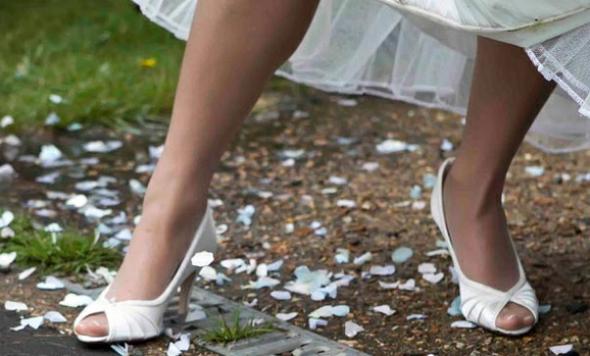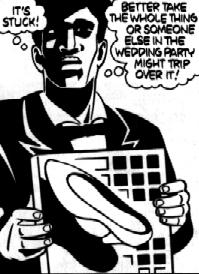
Claim: A bridesmaid walking down the aisle at a wedding caught her spike heel in a floor grate, an usher picked up the grate to retrieve the shoe, and the bride tumbled into the open hole.
Example: [Brunvand, 1989]
My aunt told me this story in the late 1950's
During a local wedding, one of the bridesmaids got the spike heel of her shoe caught in a ventilation grate in the aisle. The next usher coming down the aisle tried to pick up the shoe; the entire grate came up, so he just took it with him.
Then the bride came down the aisle and fell in the hole.
Origins: This legend about a
mortifying wedding mishap in which a bridesmaid's spiked heel pulls off a grate cover set into the floor and sends the bride tumbling into the void has been kicking around for over half a century now. It's also a prime example of how real-life events can be transmuted through changes of detail and setting into much more memorable legendary forms that spread far and wide.
This legend was originally popularized through an anecdote published in the January 1958 edition of the venerable
Without a thought for her fancy heels, the young woman sang and marched. And the heel of one shoe sank right through a hole in the register grate. Instantly she realized her predicament. She knew she couldn't hold up the whole recessional while she back-stepped to pull out her heel. She did the next best thing in the emergency. Without missing a step, she slipped her foot out of her shoe and continued up the aisle. There wasn't a break in the recessional. Everything moved like clockwork. The first man following that young woman noted the situation and, without losing a beat, reached down and picked up her shoe. The entire grate came along with it. Startled but still singing, the man continued up the aisle bearing in his hand one grate attached to one shoe. Never a break in the recessional. Everybody singing. Everything moving like clockwork. And then in tune and in time to the beat the next man stepped into the open register.
It started at the end of a Sunday morning service in an Ontario church. The choir began the recessional, singing as they marched in perfect unison up the center aisle to the back of the church. The last young lady in the women's section was wearing a new pair of shoes with needle
As tracked by folklorist Jan Harold Brunvand, the 1958 Reader's Digest version quoted above was attributed to the Canadian newspaper the Kitchener-Waterloo Record, which in turn quoted another publication called The Lutheran. where it presumably originated as a report on a real occurrence. It turned out that these account were all based on something that did indeed transpire in real life, but it didn't occur in Canada, or in a Lutheran church, or during a wedding. The underlying event had taken place more than a decade earlier at the Hanover Presbyterian Church in Hanover, Indiana, at the end of a regular church service:
who was a witness to the incident and had been the source of the first printed version [published on According to Woody Jones, he and two Beta Theta Pi fraternity brothers, Jim Stuckey and Ed Steiner, were involved in the event, which took place in Spring 1949. According to Jones, Stuckey was the one who picked up the woman's shoe along with the grate; another student behind him stepped over the hole; and Ed Steiner, a baritone, fell into it. I also checked with Woody's former college classmates. Edwin C. Steiner, Hanover class of 1950, also confirmed the story: "Yes, it was certainly I who fell into that hot air duct. I hit the hole cleanly; I didn't even scrape my toe on the edge. It was like stepping off a gigantic stair step, and I went into the hole all the way up to my thigh."
Several readers in Dayton, Ohio, said that they knew of the story from their local paper, the Dayton Journal-Herald, which had mentioned specific names. I also got a letter from Woodfin ("Woody") Jones,

Such is the story's appeal: Weddings are serious and solemn, so it pleases us to picture one where all that solemnity is shattered by a hilarious accident. Not being content with passing such a tale off as a funny story, we create a fictionalized version and repeat it as a true one.
Barbara "grate's caught!" Mikkelson
Sightings: Only Doris Day fans are likely to know this, but a non-wedding version of this legend surfaced in the 1966 film The Glass Bottom Boat. In that movie, Doris' character loses her spike heel in a floor grating during a tour of a space flight center, Rod Taylor's character picks up the shoe (with the grate with it), and Dick Martin's character drops through the resulting hole.
Last updated: 30 March 2015
Sources: |
Brunvand, Jan Harold. Curses! Broiled Again! New York: W. W. Norton, 1989. ISBN 0-393-30711-5 (pp. 167-172). Tan, Paul Lee. Encyclopedia of 7700 Illustrations. Rockville, Maryland: Assurance Publishers, 1979. ISBN 0-88469-100-4 (p. 879). Reader's Digest Treasury of Wit and Humor. Pleasantville, NY: Reader's Digest Association, 1958 (pp. 409-410). The Big Book of Urban Legends. New York: Paradox Press, 1994. ISBN 1-56389-165-4 (p. 105).
